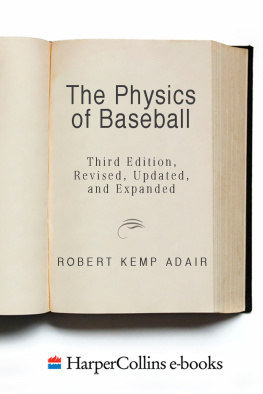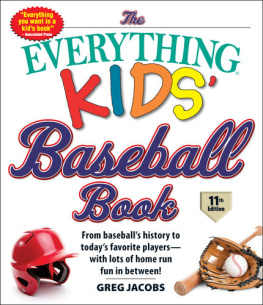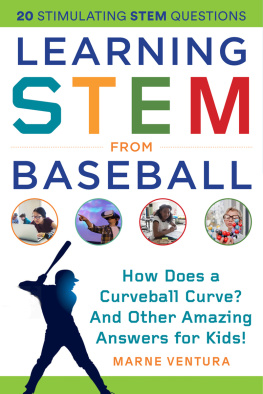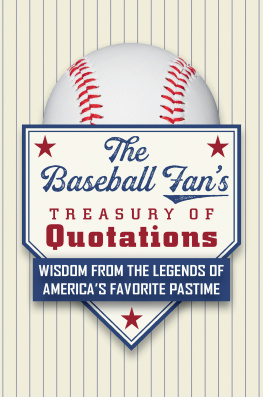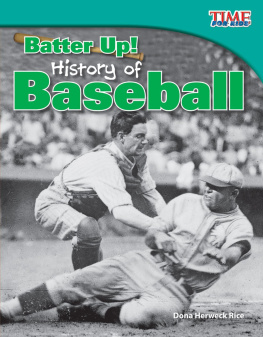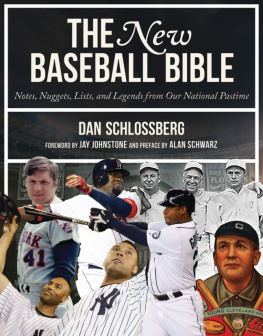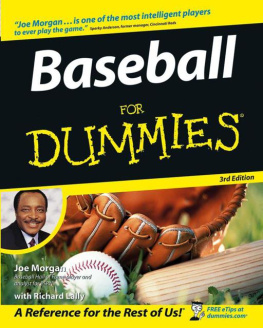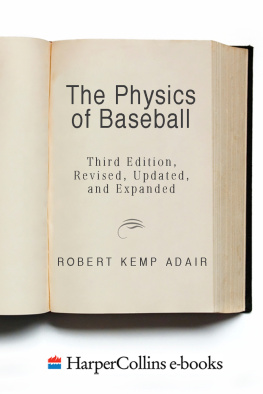To the memory of my grandfather Theodore Wiegman (18761953), who often sat with a small boy behind third base watching 3-I League baseball in the old Fort Wayne ballpark in the 1930s, and to the memory of my son, James Cleland Adair (19571978), graceful first baseman on his championship little league team.
Contents
Late in the summer of 1987, Bart Giamatti, then President of the National Baseball League and later Commissioner of Baseball, an old friend and colleague of mine from his days as professor of English and then president of Yale, asked me to advise him on the elements of baseball that might be best addressed by a physicist. I told Bart that I would be delighted to do soand that I expected that I would have so much fun at such a job that I would find it wrong to accept any payment for it. Bart, ever the English professor and sensitive to words, responded by appointing me Physicist to the National Leaguea title that absolutely charmed the ten-year-old boy that I hope will always be a part of me.
As I considered the few questions Bart posed to me, it became increasingly clear that to answer them properly, I had better understand almost all baseball as best I could. Hence, more as a delightful hobby than as an obligation, I attempted to describe quantitatively as much of the action of baseball as I could in a report to Bart Giamatti as League President. He then suggested that I publish it, suitably expanded, as a book. I was pleased that Bart saw the final manuscript before his death, and that he liked it.
Written for fun, and originally for Bart Giamatti, this book is not meant as a scholarly compendium of research on baseballthough I have borrowed extensively from the work of others. Moreover, it is not meant as the definitive treatise on the aspects of baseball that it considers. I have not hesitated to make best estimates on matters that I do not understand as well as I would like, and while I believe that I have made no egregious blunders, the physics of baseball is far from trivial and I surely will have slipped somewhere.
Although I found no errors in the first and second editions that were central to baseball, over the past decade I have learned more about the sport. Hence, I have made a number of modest changes in numbers and text in this third edition to reflect my improved understanding of the game, and have added comments on points that I had not previously addressed. These changes modify, but do not radically change, the analyses presented in the first and second editions.
Aside from such corrections and additions, in this third edition I have also added some new material on matters that I found of interest to myself, fans, and players. In particular I have material borrowed from neurophysiology that I believe illuminates the pitcher-batter duel central to the game. I have also incorporated some of the elegant researches by others that have better defined the collision of the ball with wooden bat, and have discussed home runs and the lively ball at greater length.
I have written this book for those interested in baseball, not in the principles of physics, and therefore I have slighted descriptions of the details of the calculations to which I refer. These calculations were usually conducted by simple BASIC programs on a personal computer. The few formulas which are included, segregated as Technical Notes at the end of each chapter, are introduced to provide, for those who might be especially interested, a succint description of the models I used.
Robert Kemp Adair
Hamden, Connecticut
A small, but interesting, portion of baseball can be understood on the basis of physical principles. The flight of balls, the liveliness of balls, the structure of bats, and the character of the collision of balls and bats are a natural province of physics and physicists.
In his analysis of a real system, a physicist constructs a well-defined model of the system and addresses the model. The system we address here is baseball. In view of the successes of physical analyses in understanding arcane features of naturesuch as the properties of the elementary particles and fundamental forces that define our universe (my own field of research) and the character of that universe in the first few minutes of creationit may seem curious that the physics of baseball is not at all under control.
We cannot calculate from first principles the character of the collision of an ash bat with a sphere made up of layers of different tightly wound yarns, nor do we have any precise understanding of the effect of the airstream on the flight of that sphere, with its curious yin-yang pattern of stitches. What we can do is construct plausible models of those interactions that play a part in baseball that do not violate basic principles of mechanics. Though these basic principlessuch as the laws of the conservation of energy and momentumseverely constrain such models, they do not completely define them. It is necessary that the models touch the results of observationsor the results of the controlled observations called experimentsat some points so that the model can be more precisely defined and used to interpolate between known results, or to extrapolate from them.
Baseball, albeit rich in anecdote, has not been subject to extensive quantitative studies of its mechanicshence, models of baseball are not as well founded as they might be. However connected with experience, model and systemmap and territoryare not the same. The physicist can usually reach precise conclusions concerning the character of the model. If the model is well chosen, so as to represent the salient points of the real system adequately, conclusions derived from an analysis of the model can apply to the system to a useful degree. Conversely, conclusionsalthough drawn in a logically impeccable manner from premises defined precisely by the modelmay not apply to the system if the model is a poor map of the system.
Hence, in order to consider the physics of baseball, I had to construct an ideal baseball game which I could analyze that would be sufficiently close to the real game so that the results of the analysis would be useful. The analysis was easy, the modeling was not. I found that neither my experience playing baseball (poorly) as a youth nor my observations of play by those better fitted for the game prepared me for the task of constructing an adequate model of the game. However, with the aid of seminal work by physicists Paul Kirkpatrick, Lyman Briggs, and others, and with help from discussions with other students of the game, such as my longtime associate R. C. Larsen, I believe that I have been able to arrive at a sufficient understanding of baseball so that some interesting conclusions, drawn from analyses of my construction of the game, are relevant to real baseball.
In all sports analyses, it is important for a scientist to avoid hubris and to pay careful attention to the athletes. Major league players are usually serious people, intelligent and knowledgeable about their craft. Specific, operational conclusions held by a consensus of players are seldom wrong. However, since baseball players are athletes, not engineers or physicists, their analyses and rationale may be imperfect. If players think that they hit better after illegally drilling a hole in their bat and filling it with cork, they must be taken seriously, though the reasons they give for their improvement may not be valid.
I hope that nothing in the following material will be seen by a competent player of the game to be definitely contrary to his experience in playing the game. Honed by a century of intelligent trial and error, baseball must surely be played correctlythough not everything said about that play, by players and others, is impeccable. Hence, if a contradiction arises concerning some aspect of my analyses and the way the game is actually played, I would presume it likely either that I have misunderstood that aspect myself or that my description of my conclusion was inadequate and subject to misunderstanding.

